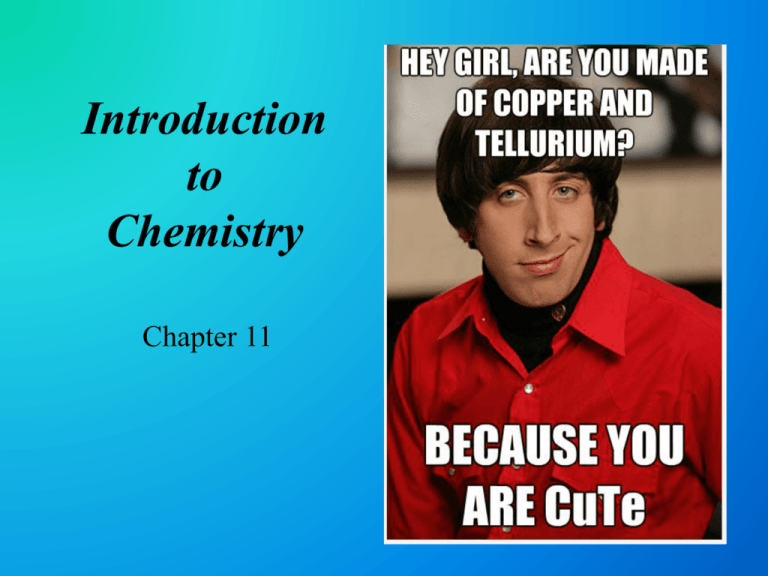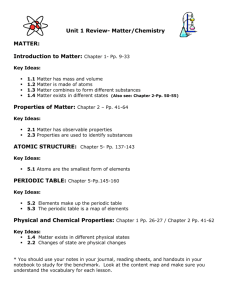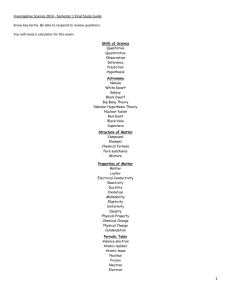Chapter 11: Introduction to Chemistry
advertisement

Introduction to Chemistry Chapter 11 Student Learning Objectives • Distinguish between physical & chemical properties • Classify, compare, name, & identify chemical quantities • Recall properties of solubility • Apply trends in the periodic table. What is chemistry? Chemistry is the study of microscopic properties. Chemical properties “Invisible” How and why atoms combine into molecules What are some physical and chemical properties? Physical Properties Chemical Properties (Macroscopic) (Microscopic) • Density • Phase • Appearance • Size • Atomic make-up • Structure • Reactivity Practice 1) How many different medicines exist for pain relief? 2) Is surface tension a microscopic or macroscopic property of matter? 3) What does the image show? Is it an example of a physical or chemical property? More Practice 4) Name the macroscopic properties of water. 5) Name the microscopic properties of water. 6) How do carbon dioxide (CO2) and water (H2O) compare and contrast? The primary difference between a physical change and a chemical change is that a chemical change produces a new substance. Some Chemical Change Indicators Color change Production of a Gas Temperature Change Light Sound How are elements, molecules, compounds & mixtures defined? Element all of one type of atom Molecule Chemical bond Molecular Formula atoms in a chemical bond attraction between atoms relative numbers of atoms in bond Question: What are the origins of the elements? A compound contains two or more types of atoms. Type Number of Atoms Diatomic Triatomic Polyatomic 2 3 4+ Practice 1) Which is not a compound? 2) How many atoms are contained in each? 3) Classify as diatomic, triatomic, or polyatomic. H 2O CaF2 NH3 O2 Classifying Mixtures A substance that is pure has only one type of element, or molecule, present. Copper Salt A mixture contains two or more distinct types of substances (atoms/molecules). Homogeneous Mixture Heterogeneous Mixture Same uniform appearance and composition throughout Consists of visibly different substances and/or phases Solution (same phase) Suspension (particles settle) Practice: Classify Each Substance 7-up Aluminum Homogenized milk Raw milk Oil and water Carbon monoxide Distilled water Air Tap water How can mixtures be separated? Filtration Distilation Desalination separate liquids and solids separate gasses, liquids, solids combines distillation and reverse osmosis Water may cross a semi-permeable membrane. (Osmosis) Osmosis: from less to more concentrated Reverse osmosis: from more to less concentrated Question Why are distillation and desalination typically not used to obtain fresh water from salt water? What is solubility? Solubility is a measure of how much solute will dissolve in a solvent to produce a stable solution. Solvent (larger amount) Solute (smaller amount) Does the dissolving Dissolves Water & Sugar Oil & Water Liquids may be miscible or immiscible. (mix or not mix) Solubility is variable. • • • • • Bond Strength Bond Types Temperature Pressure Molecular attractions Solubility has a limit, based on each individual substance and physical conditions. Concentrated Dilute Saturated Concentration = Grams Liter Practice 1) If you cannot dissolve anymore sugar in your coffee, your coffee is? 2) What is the concentration when 5 grams of sugar is added to ½ a liter of water? 3) If you have 30 mL of 25% HCl solution, how many grams of HCL are in the solution? What are the basic trends in the periodic table? The periodic table is periodic! Most of the elements in the periodic table are metals. Shiny Opaque Good Conductors Trends • Chemical reactivity decreases L R • Radius decreases along a period L R • Ionization energy increases along a period L R Practice 1) Which metals are liquid under normal atmospheric conditions? 2) Which of the following would be most reactive? a. O b. He c. Al d. Cl 3) Which of the would have the smallest radius? a. Al b. Cl Atomic Periods (rows) are periodic. Atomic Groups (columns) have similar trends. 1 amu = 1.661 x 10-24 grams Group Name Attributes IA IIA Middle IIIA VIA VIIA VIIIA Alkali Metals Alkali Earth Metals Transition Metals Metalloids Highly Reactive Halogen Gases Noble Gases High Melting Point Metals/ Non-metals Ore Forming Elements Salt Forming Elements Non-Reactive Emerald is a variety of beryl, a mineral that contains the alkaline earth metal beryllium. Lanthanides (58-71): found in geologic zones Actinides (90-103): most are synthesized in labs A Uranium Rock Practice 1) In which group are the precious metals? 2) List all attributes of Bromine (Br) that can be determined using the periodic table. What does the shell model indicate? No two electrons can have the exact same energy state. (Pauli Exclusion Principle) Electrons are arranged in particular orbitals Each electron has its own set of quantum numbers (n,l,ml, ms) which determine the energy state of the electron Atomic period indicates the number of main energy shells available in the ground state. Shell n=1 n=2 n=3 n=4 n=5 n=6 n=7 Maximum e- Allowed 2 8 8 18 18 32 32 Practice Draw the electron configuration for each atom. (Assume atoms in ground state) 1. N 2. Kr 3. Mg 4. O Valence Electrons Electrons attempt to have configurations that match those in group VIIIA. (Octet Rule) 8 − Group Number = Number Unpaired e– Valence electrons are what make the physical and chemical properties of the atoms in a group similar. More unpaired electrons = more reactive Unpaired valence electrons are used to form chemical bonds What are some rules for naming compounds? Compounds Metal is named first and then the Non-metal “Left” then “Right + ide” NaCl = Sodium Chloride HF = Hydrogen Fluoride Prefixes 1. 2. 3. 4. 5. 6. 7. 8. Mono Di Tri Tetra Penta Hexa Hept Oct CO2 = Carbon Dioxide Polyatomic Ions Polyatomic Ions are molecules made up of two or more atoms that are considered an ionic group, that have charge. 1. Name the cation (+ ion) first 2. Name the anion (- ion) second + ate CaCO3 Calcium Carbonate Practice What is the chemical name? Does it have a common name? 1. O2 5. SF6 2. H2O 6. CH4 3. KBr 7. NH3 4. O3 8. PCl5 Practice with Polyatomic Ions What is the chemical name? Does it have a common name? 1. AlPO4 2. Cu2SO4 3. KClO3 4. Fe(NO3)2 5. NaHCO3 6. NaH2PO4







